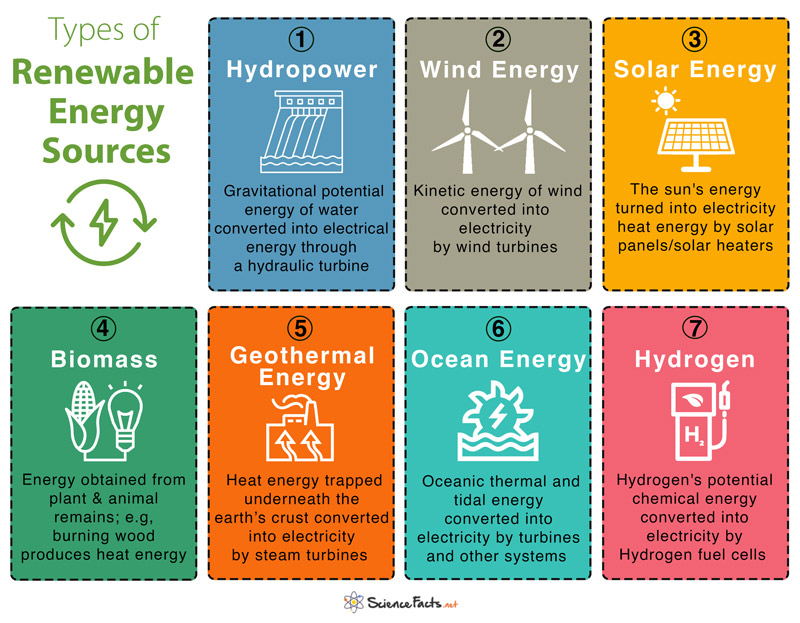Why Is Renewable Energy Important
What Are the Different Types of Renewable Energy Sources
1. Hydroelectric Energy
2. Wind Energy
3. Solar Energy
4. Biomass
5. Geothermal Energy
6. Ocean Energy
7. Hydrogen Fuel Cells
B) To increase energy security: The security of fuel supply is a serious concern worldwide due to rising energy markets and geopolitical uncertainty. So, Countries are relying on their resources to satisfy their power demands. C) Jobs and Economy: The investments in renewable energy infrastructure boost the economy of states and create new job opportunities for youth.
- Hydro-electric, 2) Wind, 3) Solar, 4) Biomass, 5) Geothermal, 6) Ocean, and 7) Hydrogen fuel cells Advantages:
Low operating cost and requires less maintenance Can be utilized for numerous other purposes such as irrigation, flood control, and water supply
Disadvantages:
Building the initial infrastructure is quite expensive Has adverse environmental effects on aquatic life due to dam and road construction, changed water flow, turbine installation
Applications:
Electric power generation through hydro-electric power plant
Advantages:
An additional source of income for farmers, and land-owners as they are paid for the lands where the wind turbines requires are installed Has the prospect of creating employment in its manufacturing and maintenance work
Disadvantages:
Power generation fluctuates as wind flow varies; no electricity can be produced in the absence of wind Wind turbines pose a threat to wildlife, especially birds and bats
Applications:
Electric power generation Pumping underground water using windmills Milling grain employing gristmills
Advantages:
Pollution-free, causes no greenhouse gas like carbon-di-oxide emission Easier to install in off-grid areas to generate electricity so houses in rural regions can get electricity Reduces household energy bills
Disadvantages:
Solar Installations tend to be costly Since its production is weather dependent, the energy flow can be significantly low on a cloudy day
Applications
Producing electricity by converting solar energy using photovoltaic cells Cooking using solar cookers and heaters Running solar pumps
Advantages:
Being widely available, it reduces the reliance on fossil fuels Generates revenue from organic waste, and it reduces the quantity of garbage to be landfilled
Disadvantages:
Burning biomass fuel like wood releases carbon dioxide into the atmosphere, leading to pollution. Due to lack of technological advancements to produce biodiesel and alcohol from biomass, it is not a widespread renewable energy source that can replace fossil fuels
Applications:
Production of biodiesel and alcohol to be used as a replacement for traditional automobile fuels Producing methane gas that can be used to generate heat, electricity, and organic chemicals
Advantages:
Does not require the burning of fossil fuels, so it does not contribute to carbon dioxide emissions Geothermal power plants have higher efficiency than solar photovoltaic cells A more reliable and steady source of electricity generation compared to solar, wind, or biomass
Disadvantages:
Modern drilling technology has limitations to drill up to a certain depth only There are only a few locations on earth where magma is close enough to the earth’s crust, which limits its scope of production.
Application:
Electricity generation
Oceanic Thermal Energy
Oceans cover about 66% of the earth’s surface (out of the total 71% covered in water), which is almost entirely exposed to the heat from the sun. This oceanic warm water is used to generate steam from a low-boiling point fluid-like Ammonia (boiling point -27°F), which drives a turbine-generator to generate electricity. According to estimation, 88,000 TWh/yr of power can be generated from this thermal energy without affecting the ocean’s thermal structure.
Oceanic Tidal Energy
This form of energy is obtained from the natural rise and fall of ocean tides that spin a turbine-connected generator. The tidal energy can produce about 2600 TWh/yr. Advantages:
Steady production is possible as the source is predictable, with regular tidal charts being available Low operating cost
Disadvantages:
Large machine installation is required, that causes disruptions to aquatic life and the ecosystem The power is weather dependent; stormy weather changes the consistency of the waves, so lower the energy output.
Applications:
Electricity generation
Advantages:
More efficient than other fuels as hydrogen has the highest calorific value (amount of heat produced on burning).
Disadvantages
Production of hydrogen is expensive Hydrogen as a fuel is highly inflammable and explosive.
Applications:
Hydrogen fuel cells can be used to drive automobiles instead of petrol or diesel engines.
Renewable energy sources have less environmental impacts and produce fewer emissions than conventional energy sources. But many of these are still under development, facing difficulties in commercialization. So, various academic and commercial sectors are investing in advanced research to implement these technologies to bring a better and brighter tomorrow for the next generation.
